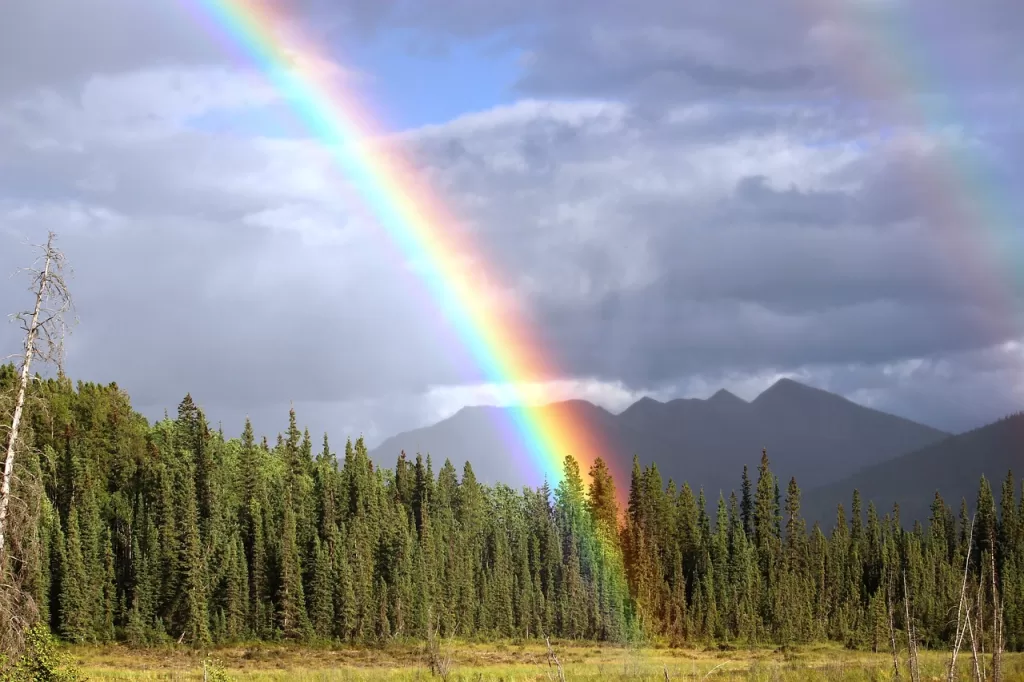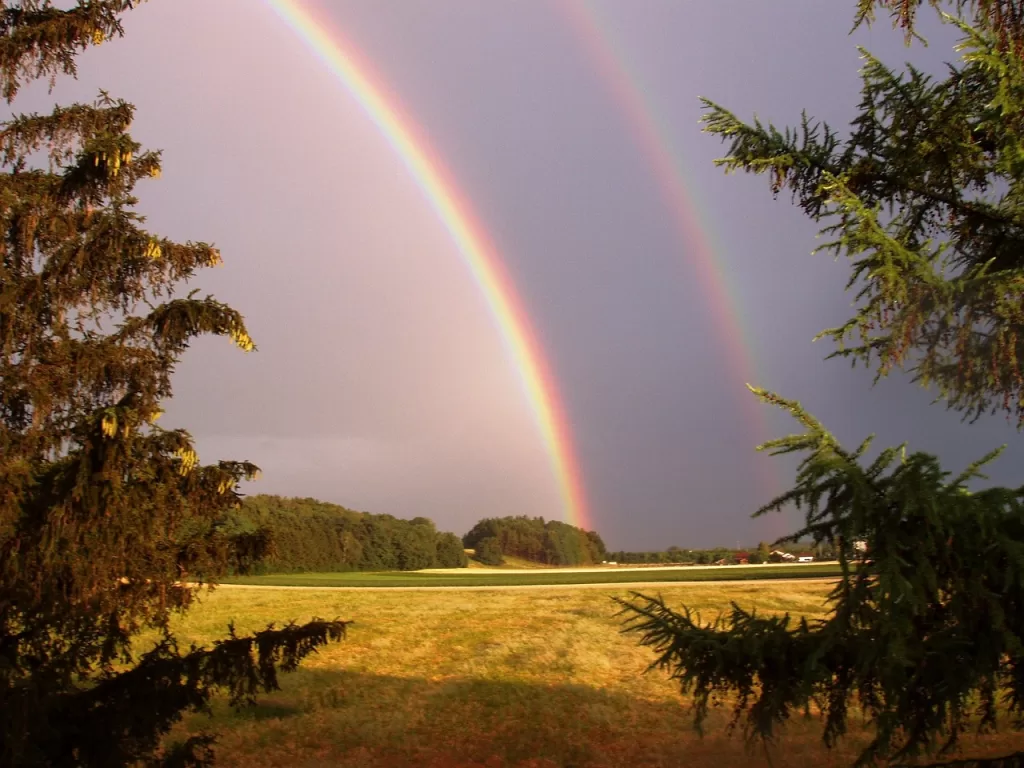
A double rainbow is a rare and majestic phenomenon that takes place when two distinct rainbows form in the sky at the same time.
It’s an impressive sight to behold, and many people have been awed by its beauty. But what causes a double rainbow, and how can you spot one?
This comprehensive guide will provide answers to these questions, as well as provide tips on where and when to look for double rainbows.
What Causes a Double Rainbow?
Double rainbows result from the intricate interplay between sunlight and raindrops. When sunlight passes through individual raindrops, it undergoes a process called refraction, causing the light to disperse into its constituent colors. This dispersion leads to the formation of a primary rainbow, which is the more frequently observed arc of colors in the sky.
However, in the case of a double rainbow, an additional reflection occurs within the raindrop before the light exits. This secondary reflection results in the formation of a second concentric arc, known as the secondary rainbow. Due to the increased angle of exit during this secondary reflection, the colors of the secondary rainbow appear inverted when compared to the primary rainbow.
Moreover, the secondary rainbow is positioned at a wider angle from the observer, making it appear above the primary rainbow. The combination of these factors – the additional reflection, inverted color sequence, and altered position – contributes to the ethereal sight of a double rainbow gracing the heavens.
How to Spot a Double Rainbow
Double rainbows are most often seen during or after a rain shower. To spot one, stand outside with your back to the sun and look for two arcs of color in the sky. The inner rainbow will appear bright and vivid, while the outer rainbow will be fainter and less colorful.
Difference Between Rainbow and Double Rainbow
A double rainbow has the same colors and order as a single rainbow – red, orange, yellow, green, blue, indigo, and violet. The only difference is that the colors of the outer rainbow are usually less intense than those of the inner rainbow.
Appearance
A rainbow appears as a single, gracefully arched band of vibrant colors in the sky. It consists of seven distinct hues, arranged in a specific sequence from red to violet. In contrast, a double rainbow astounds observers with two concentric arcs of colors. The primary rainbow, brighter and more prominent, is accompanied by a secondary rainbow, fainter and characterized by reversed color ordering.
Formation
The formation of rainbows begins as sunlight passes through raindrops, undergoing refraction and dispersion. This process causes the light to split into its constituent colors, creating a primary rainbow. In the case of a double rainbow, an additional internal reflection occurs within the raindrop, leading to the emergence of a secondary rainbow with inverted colors.
Position
Rainbows typically appear in the opposite direction of the Sun, with their center positioned directly opposite the Sun’s location. On the other hand, double rainbows manifest outside the primary rainbow, presenting a wider angle from the observer. This unique positioning contributes to the awe-inspiring sight of a double rainbow gracing the sky.
Intensity
Rainbows exhibit varying levels of brightness. The primary rainbow is generally more radiant due to receiving direct sunlight, while the secondary rainbow appears fainter as it undergoes additional reflection and dispersion.
What Does It Mean to See a Double Rainbow?

Many cultures view rainbows as symbols of good luck, prosperity, or divine intervention. Seeing a double rainbow is believed to be an especially powerful omen, and it’s often seen as a sign of hope and renewal.
Rare and Unusual Phenomenon
Double rainbows are less common than single rainbows, making their appearance special and noteworthy. Witnessing a double rainbow can be seen as a fortunate event, an encounter with something extraordinary and out of the ordinary.
Beauty and Wonder
Double rainbows are undeniably beautiful, with their dual arcs of vibrant colors adorning the sky. Their mesmerizing and ethereal nature inspires a sense of wonder, inviting contemplation of the natural world’s splendor and complexity.
Symbolic Significance
In many cultures, rainbows are considered symbols of hope, positivity, and good fortune. Seeing a double rainbow can amplify these symbolic meanings, representing an even stronger sense of optimism and abundance. It may serve as a reminder to stay hopeful and optimistic in challenging times.
Personal Reflection
The meaning of seeing a double rainbow can also be deeply personal and subjective. Some individuals may associate it with personal achievements, milestones, or moments of clarity and transformation. It can serve as a reminder to appreciate life’s beauty and embrace moments of joy.
What Are Other Types of Rainbows?
In addition to double rainbows, there are several other types of rainbows that can occur. These include monochrome rainbows, monochromatic rainbows, supernumerary rainbows, moonbows, and rainbow halos.
Monochromatic Rainbows
Monochromatic rainbows, like the white fogbow or mistbow, display a single color band or hue instead of the usual multicolored spectrum. These unique atmospheric phenomena occur when specific conditions selectively filter or disperse most of the visible light, creating a striking display of a single color.
Supernumerary Rainbows
Supernumerary rainbows are a fascinating phenomenon that occasionally appear alongside regular rainbows. They are characterized by additional, fainter, and closely spaced bands of colors located on the inner side of the primary rainbow. These extra bands, often seen as pastel hues, create a stunning and mesmerizing effect.
The formation of supernumerary rainbows is linked to the wave nature of light. When sunlight passes through raindrops during a rain shower, it undergoes diffraction, which causes the light waves to interfere with each other. This interference leads to the creation of constructive and destructive interference patterns, resulting in the appearance of supernumerary rainbows.
Moonbows
Moonbows, also called lunar rainbows, are enchanting optical phenomena that arise when moonlight passes through raindrops, producing a delicate and faint rainbow during nighttime hours. These captivating spectacles often exhibit soft and muted colors, and they are commonly witnessed during dark, misty evenings, particularly when there is a full moon illuminating the sky.
Rainbow Halos
Rainbow halos, also known as ice halos or circumhorizontal arcs, are captivating atmospheric optical phenomena. They form when sunlight passes through ice crystals in high-altitude cirrus clouds, creating a halo effect with a rainbow-like appearance. Rainbow halos are characterized by a horizontal arc of vibrant colors and are a stunning sight to behold.
Conclusion
Double rainbows are a remarkable natural phenomenon arising from the intricate interplay between sunlight and raindrops.
Understanding the scientific principles behind their formation enhances our appreciation of the captivating beauty they possess.
The allure of a double rainbow reminds us of the intricate wonders of nature and serves as a reminder to cherish these rare and captivating gifts from the skies above.
